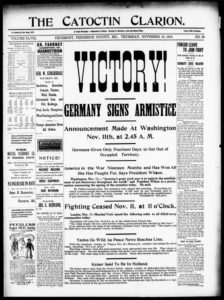Daily and weekly newspapers published in communities all across Maryland and the nation are important historical resources for investigating earlier times. Since the colonial era, these serials have brought matters of local and national significance to readers. On the day they were published, especially for an earlier generation, the pages of newsprint conveyed fresh accounts of just about everything to the reader, from disasters, revolutions, politics, and wars to everyday social happenings in our communities.

There was a time when in order to use these valuable resources you had to travel to a library or historical society that held a collection of the aging broadsheets or an institution that had filmed images, preserving the sources while also making the microfilm more broadly available. Of course, utilizing the film required staring at the aging, cranky old readers while strained eyes searched the pages scrolling slowly along.
Now that we are in the second decade of the 21st century, all of that is changing and this transformation is happening quickly. Online providers (public and commercial) are rushing to open up access to these papers, providing us with accessible traces to the past. With just a few key strokes data is often available that might have taken us days to find, if it could be located.
The e-document array is exploding exponentially now as for-profit online publishers and open source providers rush to make valuable research content available to a broader user base. In Maryland, several of our nonprofit or public institutions have created strong groups of online historical newspapers.

The Historic Maryland Newspaper Project at the University of Maryland has been leading the way by digitizing Maryland newspapers, and “making them accessible for free on the Library of Congress’ Chronicling America website.” Since the University was first awarded a National Digital Newspaper Program grant in 2012, this partnership has digitized over 107,000 pages and they will be adding another 100,000 soon. The initiative is a partnership with the University, the Library of Congress, and the National Endowment for the Humanities. To examine the titles currently available at the Library of Congress, click here.
The Maryland State Archives has a strong collection of online PDFs of Maryland serials available. These periodicals are not text searchable, but if you have an approximate date, the renderings will be of great assistance as they are clear and easy to read and the images can be manipulated. Here is the link to the online digitized collection at the Maryland Archives.
The Google Archives also has a collection of newspapers, with titles such as the Afro American from 1902 to 1922 in its virtual repository. Others titles available from Google include the Baltimore American, the American & Commercial Advertiser and much more. To check out a current index click here.

There are others. For example, the Carroll County Times (1911-2014), provided by the Carroll County Library, is available online. Preserving Somerset, from the Somerset County Library, has holdings for Crisfield and Princess Anne. The Edward H. Nabb Research Center for Delmarva History and Culture at Salisbury University has an inventory of Eastern Shore newspapers spanning the years 1745 through 1922. Click here to examine this collection.
In addition to these free sites, many subscription services, including www.genealogybank.com, www.ancestry.com, and www.newspapers.com, have growing resources. Some Maryland libraries provide access to these sites for library cardholders. Since this is an area that is rapidly changing, here is a helpful guide from the Enoch Pratt Free Library, Finding Historic Maryland Newspapers Online.
And don’t forget to check your local library as some are licensed to provide patrons with remote access. In Baltimore, the Enoch Pratt Free Library provides cardholders with access to an outstanding inventory of national newspapers. These include the Baltimore Sun (1837 – 1991), the Wall Street Journal (1889 – 1999), the Washington Post (1877 – 1999), Chicago Tribune (1849 – 1992), the Christian Science Monitor (1908-2002), and more, all from the convenience of your school or home.
These are great virtual resources as you formulate your research question for your Maryland History Day project, conduct research, and cull insights and interpretations from fascinating primary sources.
Mike Dixon is an award-winning historian, public speaker and author. A resident of Cecil County, Maryland, Dixon’s research features mid-Atlantic’s regional and local history. He travels widely for research and to conduct lectures encouraging public interest and participation in the preservation of the area’s past. He stresses an importance of understanding the relationship between the past and the present.

